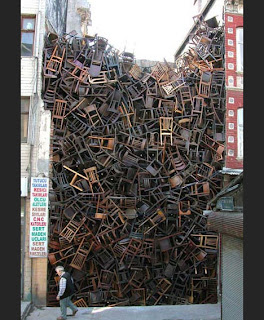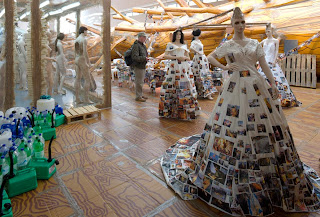Enstalasyon- Installation art
Four Letter Words is an installation made by Rob Seward
Enstalasyon sanatı, geleneksel sanat eserlerinin aksine, çevreden bağımsız bir sanat nesnesi içermeyip belirli bir mekan için yaratılan, mekanın niteliklerini kullanıp irdeleyen ve izleyici katılımının temel bir gereklilik olduğu sanat türüdür. Kapalı veya açık mekanlarda yapılabilir.
enstalasyon : Fransızca enstalasyon (installation) sözü son zamanlarda dilimizde daha çok "tesis etme, döşeme, yerleştirme" anlamıyla kullanılmaktadır.
Kökleri kavramsal sanat ve hatta 20. yüzyıl başındaki Marcel Duchamp'ın hazır-yapımları ve
Kurt Schwitters'e kadar giden enstalasyon, diğer adıyla yerleştirme sanatı, çağdaş sanatta mimarlık ve performans dışında birçok başka görsel sanat disiplininden de destek alan melez (hibrid) bir tarzdır. Uygulanmasında sanat eserinin sergileme veya gösterim aşamalarını vurgulayan yerleştirme, 1970'lerde şekillenmiştir.
1960'ların ABD ve Avrupa'sında asamblaj ('assemblage') ve çevre terimleri sanatçıların belli bir mekanda bir araya getirdikleri malzemeler için kullanılsa da yerleştirme tabiri sadece eserlerin sergilenme şekli, örneğin resimlerin duvara ne şekilde ve nasıl bir düzende asıldığını ifade etmek için kullanılıyordu. Zamanla galeri mekanının farkındalığı ile ve sanat eserinin mekandan bağımsız gözlenemeyeceği/tecrübe edilemeyeceği fikriyle yerleştirme şekli ve mekan ön plana çıkarılmaya başlanmıştır.
1960'larda 'bir çevre olarak sanat eseri' fikri, izleyicinin sadece bakmakla kalmayıp dünyada yaşadığı gibi sanat eserinin içinde 'yaşaması', hatta zaman zaman onun bir parçası olması beklentisini getirdi.
Günümüz enstalasyonlarında günlük ve doğal malzemelerin yanısıra video, ses, performans, bilgisayarlar ve Internet gibi yeni mecralar da kullanılmaktadır. Önceleri radikal bir sanat yaratım biçimi olarak çıkan yerleştirme sanatı, 1980'lerden itibaren müzeler ve galeriler tarafından tamamen kabul görmüş, 20. yüzyıl sonlarında baskın sanat türü olmuş ve hala da bu özelliğini korumaktadır.
Installation art can be either temporary or permanent. Installation artworks have been constructed in exhibition spaces such as museums and galleries, as well as public and private spaces. The genre incorporates a broad range of everyday and natural materials, which are often chosen for their "evocative" qualities, as well as new media such as video, sound, performance, immersive virtual reality and the internet. Many installations are site-specific in that they are designed to exist only in the space for which they were created. A number of institutions focusing on Installation art were created from the 1980s onwards, suggesting the need for Installation to be seen as a separate discipline. These included the Mattress Factory, Pittsburgh, the Museum of Installation in London, and the Fairy Doors of Ann Arbor, MI, among others.
Installation art came to prominence in the 1970s but its roots can be identified in earlier artists such as Marcel Duchamp and his use of the readymade and Kurt Schwitters' Merz art objects, rather than more traditional craft based sculpture. The "intention" of the artist is paramount in much later installation art whose roots lie in the conceptual art of the 1960s. This again is a departure from traditional sculpture which places its focus on form. Early non-Western installation art includes events staged by the Gutai group in Japan starting in 1954, which influenced American installation pioneers like Allan Kaprow. Wolf Vostell shows his installation „6 TV De-coll/age“ in 1963 at the at the Smolin Gallery in New York.
Installation as nomenclature for a specific form of art came into use fairly recently; its first use as documented by the OED was in 1969. It was coined in this context in reference to a form of art that had arguably existed since prehistory but was not regarded as a discrete category until the mid-twentieth century. Allan Kaprow used the term “Environment” in 1958 (Kaprow 6) to describe his transformed indoor spaces; this later joined such terms as “project art” and “temporary art.”
Essentially, installation/environmental art takes into account a broader sensory experience, rather than floating framed points of focus on a “neutral” wall or displaying isolated objects (literally) on a pedestal. This may leave space and time as its only dimensional constants, implying dissolution of the line between "art" and "life"; Kaprow noted that “if we bypass ‘art’ and take nature itself as a model or point of departure, we may be able to devise a different kind of art… out of the sensory stuff of ordinary life” (Kaprow 12).
This Too Shall Pass by OK Go / RGM Version (ınstallation-motion-performance)
Installation art describes an artistic genre of three-dimensional works that are often site-specific and designed to transform the perception of a space. Generally, the term is applied to interior spaces, whereas exterior interventions are often called Land art; however, the boundaries between these terms overlap.Installation art can be either temporary or permanent. Installation artworks have been constructed in exhibition spaces such as museums and galleries, as well as public and private spaces. The genre incorporates a broad range of everyday and natural materials, which are often chosen for their "evocative" qualities, as well as new media such as video, sound, performance, immersive virtual reality and the internet. Many installations are site-specific in that they are designed to exist only in the space for which they were created. A number of institutions focusing on Installation art were created from the 1980s onwards, suggesting the need for Installation to be seen as a separate discipline. These included the Mattress Factory, Pittsburgh, the Museum of Installation in London, and the Fairy Doors of Ann Arbor, MI, among others.
Installation art came to prominence in the 1970s but its roots can be identified in earlier artists such as Marcel Duchamp and his use of the readymade and Kurt Schwitters' Merz art objects, rather than more traditional craft based sculpture. The "intention" of the artist is paramount in much later installation art whose roots lie in the conceptual art of the 1960s. This again is a departure from traditional sculpture which places its focus on form. Early non-Western installation art includes events staged by the Gutai group in Japan starting in 1954, which influenced American installation pioneers like Allan Kaprow. Wolf Vostell shows his installation „6 TV De-coll/age“ in 1963 at the at the Smolin Gallery in New York.
Installation as nomenclature for a specific form of art came into use fairly recently; its first use as documented by the OED was in 1969. It was coined in this context in reference to a form of art that had arguably existed since prehistory but was not regarded as a discrete category until the mid-twentieth century. Allan Kaprow used the term “Environment” in 1958 (Kaprow 6) to describe his transformed indoor spaces; this later joined such terms as “project art” and “temporary art.”
Essentially, installation/environmental art takes into account a broader sensory experience, rather than floating framed points of focus on a “neutral” wall or displaying isolated objects (literally) on a pedestal. This may leave space and time as its only dimensional constants, implying dissolution of the line between "art" and "life"; Kaprow noted that “if we bypass ‘art’ and take nature itself as a model or point of departure, we may be able to devise a different kind of art… out of the sensory stuff of ordinary life” (Kaprow 12).


















































































































Hiç yorum yok:
Yorum Gönder